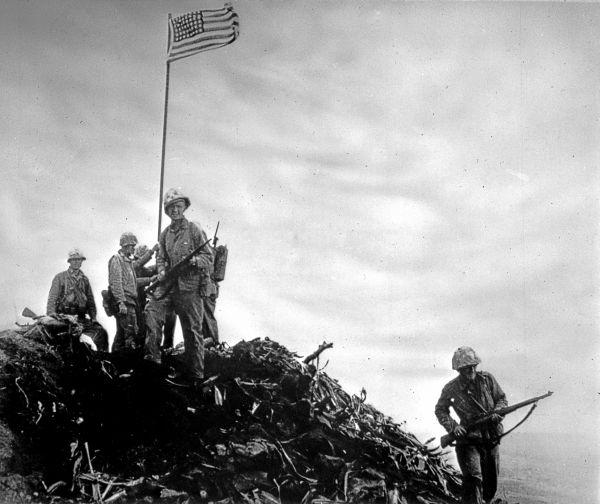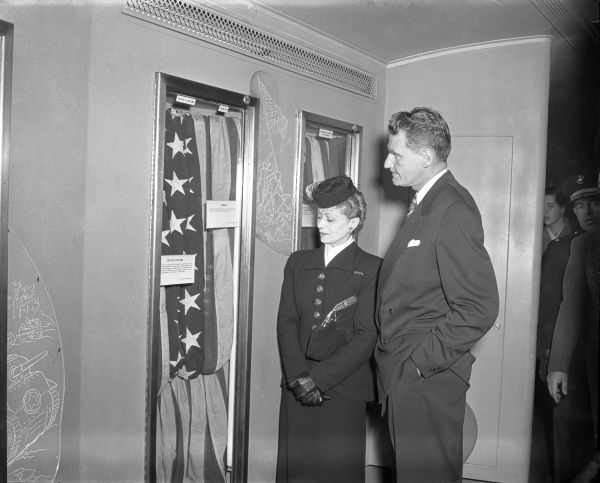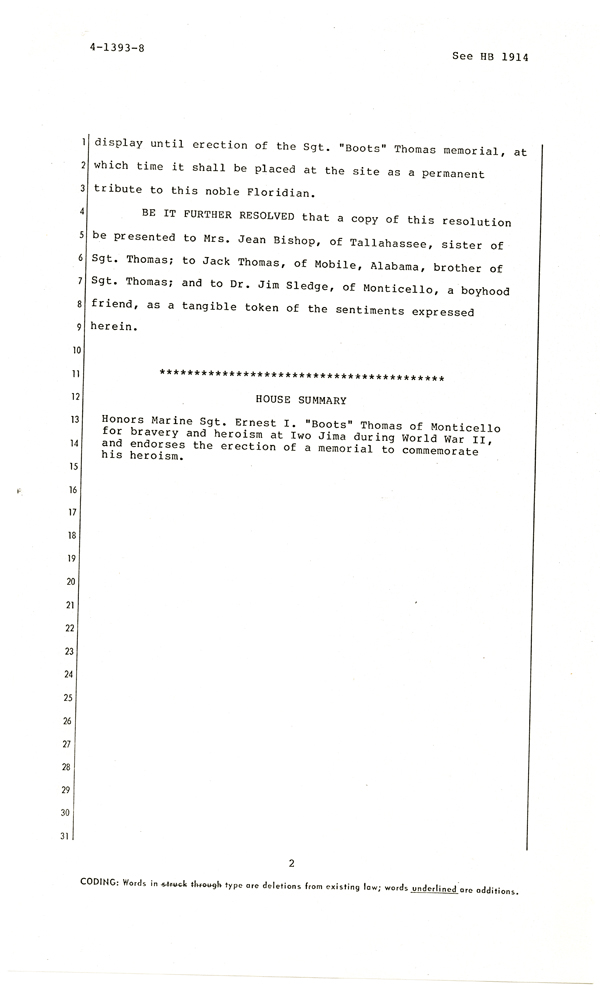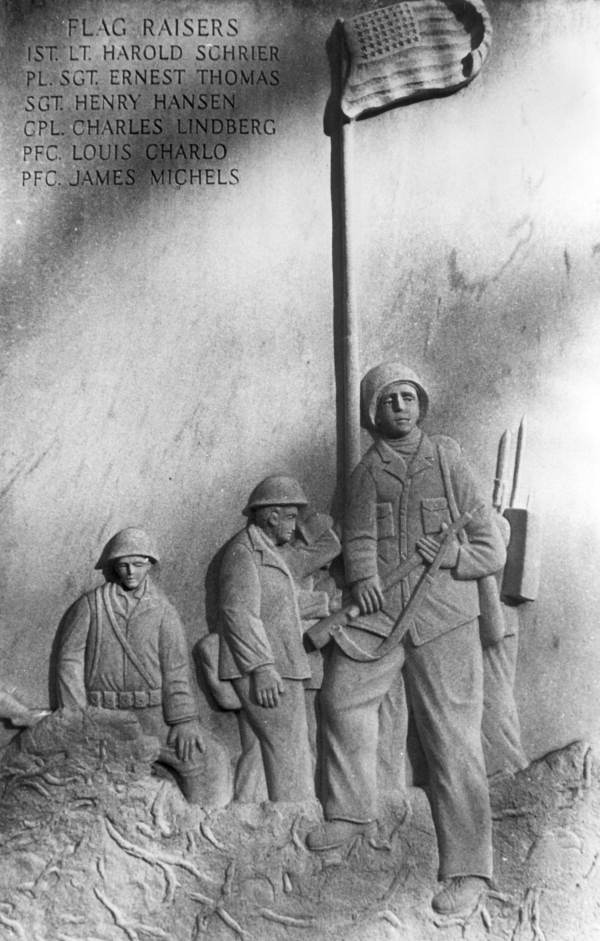Description of previous item
Description of next item
Ernest "Boots" Thomas: Florida's Unsung Hero
Published February 2, 2018 by Florida Memory
On the morning of February 23, 1945, a group of brave Marines, surrounded by enemy fire, made their way to the top of Mount Suribachi on Iwo Jima, Japan, in the midst of a battle for the island. After nearly four days of fighting, six Marines planted a flag atop the 550-foot summit as a symbol of hope and endurance to encourage their brothers in arms to keep fighting. This event preceded a second flag raising four hours later in the same spot that was immortalized in a photograph taken by Associated Press photographer Joe Rosenthal.

A sculpture of the second flag raising on Iwo Jima inspired by Joe Rosenthal’s famous photograph. The sculpture was located at Cape Coral Gardens in Cape Coral, Florida, until it was moved to Four Mile Cove Ecological Preserve.
Staff Sergeant Louis R. Lowery photographed the first flag raising on the morning of February 23. These six infantrymen were from the 3rd Platoon, Company E, Second Battalion, 28th Marines, Fifth Marine Division. One of the men on the summit was Platoon Sergeant Ernest Ivy “Boots” Thomas Jr. who grew up in the small city of Monticello in the Florida Panhandle. Just shy of his 21st birthday, this young platoon sergeant bravely led his men up the summit that morning to help plant the flag and was then immediately whisked away to report the event to the press. A second flag was raised because it was decided that the first flag wasn’t large enough for all American forces to see.

Photograph taken by Louis Lowery of the first flag raising on Iwo Jima, February 23, 1945. Platoon Sergeant Thomas stands on the mound with his rifle and faces the camera. Corporal Charles W. Lindberg, Navy Pharmacist’s Mate 2nd Class John Bradley, Sergeant Henry Hansen, 1st Lieutenant Harold G. Schrier and Private Philip L. Ward are also in the photograph.
Born in Tampa to Ernest and Martha Thomas, “Boots,” as some of his friends called him, graduated from Monticello High School and attended Tri-State College in Angola, Indiana, for one year. He enlisted in the Marine Corps in 1942 following the attack on Pearl Harbor in December 1941. After basic training, Thomas stayed to work as a drill instructor but continued to request combat duty. In 1944, he was sent overseas, and his first and only combat experience was on Iwo Jima. On February 21, two days after landing on Iwo Jima, Thomas’s platoon commander was wounded in action. Under enemy fire, Thomas assumed command and continued the assault. His men were successful in defeating the enemy in this sector and Thomas’s valiant efforts earned him the Navy Cross for heroism. Two days later, Thomas was on the summit with five of his men raising the American flag. As the Battle of Iwo Jima continued, thousands of men on both sides lost their lives, including Thomas, who was killed by enemy gun fire on March 3. He was buried at Iwo Jima, but his body was returned to Monticello after the war and laid to rest at Roseland Cemetery. The Navy Cross was awarded posthumously to Platoon Sergeant Thomas and presented to his mother in June 1946.

Platoon Sergeant Thomas’s mother, Martha, viewing a display of World War II flags at the Historic Capitol in Tallahassee with Governor Millard F. Caldwell, 1945.
In 1978, there was a push to honor the fallen soldier from Florida with a memorial in Monticello. State Senator Pat Thomas addressed the Senate on May 17, 1978, with Senate Concurrent Resolution 1024, to honor the bravery and heroism of Platoon Sergeant Thomas and endorse building a memorial in his honor. In his speech to the Florida Senate, Senator Thomas explained the need for the memorial saying, “We sometimes take for granted the freedoms we enjoy, which other men fought and died to preserve. So I think it is appropriate for us to occasionally take time to reflect on those great men and their great deeds.” Platoon Sergeant Thomas’s sister and brother-in-law, Jean and Billy Bishop, were on hand to receive a copy of the resolution. Senator Thomas’s speech from Series S1238, box 42, tape 12 can be heard below.


Copy of SCR 1024 recognizing the heroism of Sergeant Thomas and endorsing a memorial dedicated to him, May 17, 1978. It was also endorsed by the Florida House of Representatives with HB 1914. State Archives of Florida, Series 18, Box 636, Folder SRC 1024 by Sen. P. Thomas.
Three years later, on February 22, 1981, the memorial to Thomas was unveiled at a ceremony in Monticello. The monument is eight feet tall and five feet wide and depicts the first flag raising. Thomas’s brother, Jack Thomas, and sister, Jean, were present at the unveiling, as were some of the men who served with Thomas at Iwo Jima. Today, visitors to the memorial can take a moment to remember the sacrifice Platoon Sergeant Thomas and many other service members made for their country during World War II.

The monument to the first flag raisers on Iwo Jima located in Monticello, Florida, 1981. In a 2016 investigation by the Marine Corps, it was discovered that Private First Class James Michels and Private First Class Louis Charlo were not on the summit that day. The official record now states that Navy Pharmacist’s Mate 2nd Class John Bradley and Private Philip L. Ward were there that day.
A plaque describing Sergeant Thomas’s heroism stands by his grave at Roseland Cemetery in Monticello, Florida, 2018.
The monument in Monticello is located near 935 West Washington (US-90). Thomas’s grave is located at Roseland Cemetery in Monticello and includes a plaque dedicated to his heroism.
Resources
Bacon, Lance M. “Marines Say Men in First Iwo Jima Flag-Raising Photo Were Also Misidentified.” Marine Corps Times, August 24, 2016. https://www.marinecorpstimes.com/2016/08/24/marines-say-men-in-first-iwo-jima-flag-raising-photo-were-also-misidentified/.
Dailey, Ryan. “‘Boots Thomas: a Marine, a Hero and a Friend.” Tallahassee Democrat, October 29, 2015. http://www.tallahassee.com/story/news/2015/10/29/boots-thomas-marine-hero-and-friend/74805402/.
Goldstein, Richard. “Joe Rosenthal, Photographer at Iwo Jima, Dies.” New York Times, August 21, 2006. http://www.nytimes.com/2006/08/21/business/media/22rosenthalcnd.html.
Hayes, Paula. “Brave Local Man Hero On Iwo Jima.” Monticello News, February 23, 1978. State Library of Florida, Vertical File, Thomas-Thomason.
Journal of the Senate, Number 29, May 17, 1978, pages 388-389. http://archive.flsenate.gov/data/Historical/Senate%20Journals/1970s/1978/35-379TO40305_17_78.PDF.
“Thomas Memorial To Be Dedicated.” Monticello News, February 19, 1981. State Library of Florida, Vertical File, Thomas-Thomason.
Cite This Article
Chicago Manual of Style
(17th Edition)Florida Memory. "Ernest "Boots" Thomas: Florida's Unsung Hero." Floridiana, 2018. https://www.floridamemory.com/items/show/332826.
MLA
(9th Edition)Florida Memory. "Ernest "Boots" Thomas: Florida's Unsung Hero." Floridiana, 2018, https://www.floridamemory.com/items/show/332826. Accessed December 19, 2025.
APA
(7th Edition)Florida Memory. (2018, February 2). Ernest "Boots" Thomas: Florida's Unsung Hero. Floridiana. Retrieved from https://www.floridamemory.com/items/show/332826

 Listen: The World Program
Listen: The World Program